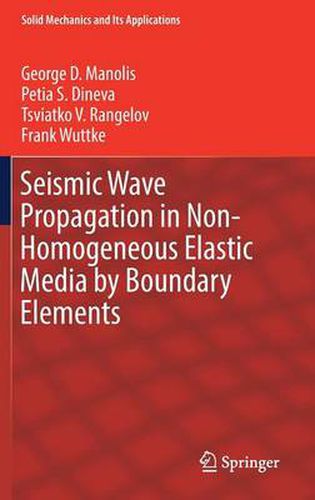Readings Newsletter
Become a Readings Member to make your shopping experience even easier.
Sign in or sign up for free!
You’re not far away from qualifying for FREE standard shipping within Australia
You’ve qualified for FREE standard shipping within Australia
The cart is loading…






This title is printed to order. This book may have been self-published. If so, we cannot guarantee the quality of the content. In the main most books will have gone through the editing process however some may not. We therefore suggest that you be aware of this before ordering this book. If in doubt check either the author or publisher’s details as we are unable to accept any returns unless they are faulty. Please contact us if you have any questions.
This book focuses on the mathematical potential and computational efficiency of the Boundary Element Method (BEM) for modeling seismic wave propagation in either continuous or discrete inhomogeneous elastic/viscoelastic, isotropic/anisotropic media containing multiple cavities, cracks, inclusions and surface topography. BEM models may take into account the entire seismic wave path from the seismic source through the geological deposits all the way up to the local site under consideration.
The general presentation of the theoretical basis of elastodynamics for inhomogeneous and heterogeneous continua in the first part is followed by the analytical derivation of fundamental solutions and Green’s functions for the governing field equations by the usage of Fourier and Radon transforms. The numerical implementation of the BEM is for antiplane in the second part as well as for plane strain boundary value problems in the third part. Verification studies and parametric analysis appear throughout the book, as do both recent references and seminal ones from the past.
Since the background of the authors is in solid mechanics and mathematical physics, the presented BEM formulations are valid for many areas such as civil engineering, geophysics, material science and all others concerning elastic wave propagation through inhomogeneous and heterogeneous media.
The material presented in this book is suitable for self-study. The book is written at a level suitable for advanced undergraduates or beginning graduate students in solid mechanics, computational mechanics and fracture mechanics.
$9.00 standard shipping within Australia
FREE standard shipping within Australia for orders over $100.00
Express & International shipping calculated at checkout
This title is printed to order. This book may have been self-published. If so, we cannot guarantee the quality of the content. In the main most books will have gone through the editing process however some may not. We therefore suggest that you be aware of this before ordering this book. If in doubt check either the author or publisher’s details as we are unable to accept any returns unless they are faulty. Please contact us if you have any questions.
This book focuses on the mathematical potential and computational efficiency of the Boundary Element Method (BEM) for modeling seismic wave propagation in either continuous or discrete inhomogeneous elastic/viscoelastic, isotropic/anisotropic media containing multiple cavities, cracks, inclusions and surface topography. BEM models may take into account the entire seismic wave path from the seismic source through the geological deposits all the way up to the local site under consideration.
The general presentation of the theoretical basis of elastodynamics for inhomogeneous and heterogeneous continua in the first part is followed by the analytical derivation of fundamental solutions and Green’s functions for the governing field equations by the usage of Fourier and Radon transforms. The numerical implementation of the BEM is for antiplane in the second part as well as for plane strain boundary value problems in the third part. Verification studies and parametric analysis appear throughout the book, as do both recent references and seminal ones from the past.
Since the background of the authors is in solid mechanics and mathematical physics, the presented BEM formulations are valid for many areas such as civil engineering, geophysics, material science and all others concerning elastic wave propagation through inhomogeneous and heterogeneous media.
The material presented in this book is suitable for self-study. The book is written at a level suitable for advanced undergraduates or beginning graduate students in solid mechanics, computational mechanics and fracture mechanics.